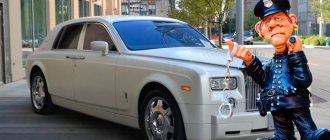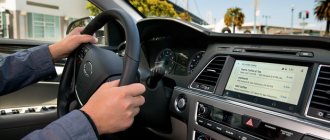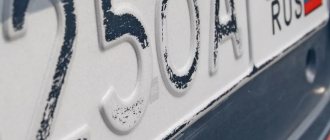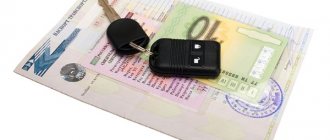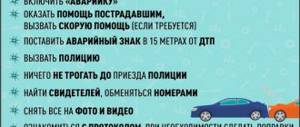- January 9, 2020
- Automobile law
- Inessa Zhebriakova
Every day, inspectors in cities stop vehicles and hold their drivers accountable for improperly tinted front windows. But do traffic police officers have the right to act in this way outside a stationary post?
What should be the rules for measuring tint? How should motorists behave and what should they pay attention to so that their rights are not violated? We will talk about this and much more in the article.
Law allowing tint inspection
The Code of Administrative Offenses of the Russian Federation has an article numbered 12.5. Part 3.1 presents the responsibility for installing color film on the windshield, as well as front side windows, which reduce light transmittance. If the car is equipped with glass that differs from the standard according to technical regulations, this fact will constitute an offense. You cannot drive such a vehicle.
Clause 4.3 of technical regulation 018/2011 specifies the minimum level of light transmission of the side front and windshields - 70%. The law prohibits dark tinting in the form of a film, removable tinting, or “curtains”.
Now all glass is checked in accordance with GOST 32565-2013 “Glass, safe for land transport. Technical conditions".
What is the basis for measuring tint?
Tint measurements are carried out to determine the light transmittance of the glass. If the indicators do not meet the acceptable values, the vehicle is prohibited from being used, since its operation is considered unsafe.
Current legislation requires that the minimum level of light transmission of the windshield and side windows be at least 70%. There are no restrictions on the coverage of rear windows, with the exception of the prohibition on the use of mirror tinting.
The regulatory framework governing the inspection of tinting:
| Traffic rules | It is prohibited to use the vehicle if the driver’s visibility is obstructed due to the coating applied to the window or additional objects. |
| Technical regulations of the Customs Union | Determines the light transmission rate of glass not lower than 70%. |
| Code of Administrative Offenses of the Russian Federation | Provides for administrative responsibility for operating a vehicle in violation of the above requirements. Establishes the need to use special means to measure the level of light transmission and defines suitable measuring instruments. |
| GOST 32565-2013 | Regulates the technique for determining the light transmittance of glass. |
What devices are allowed for measuring tint?
The device used to check the degree of light transmission is called a taumeter. Now the traffic police uses taumeters marked:
- "Blik-N";
- "Blik+";
- "Tonic";
- "Light".
The error of these devices should not exceed 2 percent. The taumeter is selected depending on the thickness of the glass being tested. All glass up to 7.5 mm thick can be measured with any device, and for glass with greater thickness, “Blik+” is provided.
What are the requirements for a taumeter?
To measure tint according to GOST, you need to check the taumeter on time. Certification is carried out by the commission on measuring devices. There are some rules that determine the state of the taumeter:
- The certification commission checks the taumeter once every 12 months.
- The person responsible for the inspection puts an individual seal on it and issues a certificate.
- If there are no identification marks on the taumeter, the readings from the device can be considered unreliable. Such results cannot be included in regulations and a fine cannot be issued for them.
- The supply voltage range should be from 11.4 to 12.6 V.
- The certificate can be kept in the traffic police department, and a plate containing the verification date must be attached to the device.
What devices are used to measure tint?
A device used to measure the degree of light transmission of glass is called a taumeter. The traffic police uses the following devices:
- "Blik";
- "Blik+";
- "Light";
- "Tonic".
They all work on the same principle, but differ in some characteristics. The most popular taumeter is the Blik. This device is certified by the Commission on Measuring Technology. Accordingly, it is used by traffic police inspectors throughout the Russian Federation.
In order for the readings of the Blik device to be considered correct, it must meet the following requirements:
- The device must be tested by a certification body at least once a year.
- Passing the test is confirmed by a seal and certificate. There must also be a label on the device confirming the testing date. The test certificate must be kept at the traffic police department.
- If there is no seal, the device readings cannot be used as evidence in court.
- The operating voltage of the device is 11.4-12.6 V. If you deviate from these parameters, Blik may provide incorrect information.
Measurements can be taken at any time of the day - lighting does not affect the taumeter readings. It independently generates a beam of light, showing the percentage of light transmission of the glass.
If a motorist considers the measurement results to be incorrect, he can file a complaint with the traffic police department. Based on this request, a repeat inspection will be carried out, the place and time of which will be agreed upon with the owner of the car.
Who has the right to measure the light transmittance of glass?
Road Technical Supervision, as well as any other traffic police officer who has a rank, can check the technical condition of a car. Other services do not have the right to check the level of light transmittance of car windows.
The special rank is regulated by the Law “On Police”. This can be absolutely any traffic police officer from junior to senior management.
The rules for measuring tinting imply checking the level of light transmittance of glass at a police control post, as well as at stationary traffic police posts.
Measuring tint at night
They detained me for tinting, they did it and measured it in flagrant violation of the law. The following violations were committed:
1) When supervising road traffic, control over the design and technical condition of vehicles is carried out at stationary posts and police control posts, vehicle checkpoints. The traffic police inspector who stopped him on the street. Sovetskaya 42 a - had nothing to do with the above posts. The current legislation does not provide for the possibility for a traffic police inspector to carry out these actions outside of stationary posts and police control posts and checkpoints. Moreover, the traffic police inspector did not have the right to take measurements, since he was not an inspector of technical supervision of the traffic police;
2) The measurement was carried out in violation of the mandatory conditions and requirements, which is confirmed by the appealed Resolution. The DPS did not comply with the correct conditions for carrying out measurements (temperature, atmospheric pressure, air humidity), since compliance of these conditions with GOST requirements is possible only in a room specially designed for measurement (which is why the law gives the right to carry out such measurements to specialized technical supervision units).
3) The measurement was carried out by the inspector at two points, instead of three (video recording confirmation);
4) The required seal was missing on the “Tonic” measuring device No. 10669;
5) Upon request, a copy of the certificate for the device was presented, i.e. with a black seal, and not with a blue one as it should be by law, or a notarized copy of the certificate;
6) The operating manual for the device was not presented;
7) The type of glass and its thickness matter. The inspector did not determine what type of glass is installed on my car and their thickness;
 When taking measurements, the inspector ignored the requirements of the instructions for the device, the vehicle glass and the device sensor were not wiped, that is, the measurement was carried out without preliminary preparation of the device from the outside of the car, and not from the inside, as required by the instructions;
When taking measurements, the inspector ignored the requirements of the instructions for the device, the vehicle glass and the device sensor were not wiped, that is, the measurement was carried out without preliminary preparation of the device from the outside of the car, and not from the inside, as required by the instructions;
9) the traffic police inspector who carried out the measurement, in violation of clause 2.3.3.1 of the operating instructions for the Tonic device, did not calibrate the device level in operating mode before starting the measurement, which led to unreliable readings from the device. Thus, the readings of the “Tonic” device used to measure the light transmittance of my car windows are unacceptable evidence;
10) according to the traffic police inspector “The device can work at night and at different temperatures.”
According to the operating manual for the Tonic glass light transmittance meter, measurements are carried out in accordance with clause 1.1.1.2 Operating conditions of the device: ambient temperature from minus 10 to 40 ° C; relative humidity up to 95% at 30°C; atmospheric pressure from 84 to 106.7 kPa.
He considers this conclusion of the traffic police inspector to be untrue, since the operating manual for the Tonic device indicates the operating temperature range at which the device itself can operate, which in itself does not mean the possibility of taking measurements of automobile glass at the same temperature range. To measure the light transmittance of automobile glass, there is a special GOST 27902-88. In other words, the device can be used at -50 C and the ambient temperature may not affect it, but it, like humidity and air pressure, will certainly affect the physical properties of the glass itself, so the data will be distorted. That is why, when measuring the light transmittance of car windows, the traffic police must be guided by the requirements of GOST 27902-88, and must be carried out at stationary posts, control posts, and vehicle checkpoints. The place where I was stopped was not a fixed post, checkpoint or control post. I believe that the traffic police inspector, by his actions, expressed in carrying out the measurement methodology established by the state standard of the Russian Federation, namely measuring the light transmittance of automobile glass in violation of the air humidity established for this measurement, violated Article 19.19 of the Code of Administrative Offenses of the Russian Federation.
Question: if you are arrested again for not removing the tint, what are the consequences? Is it possible not to roll up the windows of a car if a traffic police officer asks for it? Thank you.
Weather
Tinting is checked only under certain weather conditions:
- Atmospheric pressure should be within 760 mmHg (+/-30).
- Permissible air humidity is 60% (+/-15).
- The air temperature should vary between 20-25 degrees. Some taumeters can also be used at higher temperatures.
- In winter, air temperatures should not be lower than -10 degrees.
Tinting is not measured in rain or fog. Many people are interested in the question of whether it is possible to check the tint at night. There are no restrictions regarding the time frame - measurements can be taken even late at night.
Tinting rules
The light transmission of glass is checked in accordance with GOST 27902. Special requirements are imposed on windshields - heavy tinting is prohibited by law.
The level of light transmission is determined using the following instruments:
- for glass with a thickness of less than 7.5 mm, the Blik device is used;
- if the glass thickness exceeds 7.5 mm, then the Blik+ device is used.
Measuring instruments are highly accurate - the degree of absolute error does not exceed 2%. To obtain correct results, measurements must take place under the following conditions:
- Air humidity – 60%. Deviation of no more than 20% in both directions is allowed.
- Air temperature - 20 degrees. The maximum deviation is 5 degrees.
- Pressure ranges from 86-106 kPa.
Many car enthusiasts ask the question: “Is it possible to measure tint in the rain?” Air humidity is an important factor when taking measurements. If there is an excess of it, the measuring device will show incorrect data. Therefore, it is prohibited to measure tinting in fog or rain. Such actions of a traffic police inspector are considered unlawful.
How to check glass for light transmittance
The rules for measuring tint provide the following algorithm of actions:
- The inspector measures the current air temperature and humidity, and atmospheric pressure.
- The glass must be wiped until clean and dry.
- You can measure if the device has an error of 2% or less.
- The inspector presents the driver with a certificate or shows a sign containing the date of inspection of the tuamere, a protocol, or a personal document according to which he has the right to carry out measurements.
How is tint measured correctly?
In addition to the permitted light transmittance of glass, you need to know the requirements for the procedure for measuring tinting. Invalid values obtained as a result of incorrect measurements may be invalidated.
To measure the degree of darkness, a taumeter is used - a device that measures the percentage of sunlight passing through glass. The light measuring device must be checked annually to confirm its serviceability. The driver must ensure that the taumeter is approved for use by checking the integrity of the seal and the date of the last verification.
Before taking measurements, the car owner must familiarize himself with the following documents:
| Document | What needs to be checked/recorded |
| Confirmation of compliance of the measuring device with GOST | Check the availability of the document. Record in the protocol the fact of his absence if the employee does not provide confirmation. |
| Device verification results | Check the error indicator and the date of verification of the device. The error should not exceed 2%. The taumeter must have been verified less than a year ago. |
| Confirmation of the employee’s ability to use a taumeter | Make sure that the employee has the right to take measurements. |
The absence of these documents or their non-compliance with the requirements deprives the measurement result of evidential value.
To carry out measurements, the taumeter is connected to the car's cigarette lighter. Most devices require 12 volts to operate. If the cigarette lighter is faulty, the driver has the right to refuse the inspector to connect the taumeter in his vehicle.
The light transmittance measurement is carried out on a clean and dry surface. There should be no films, dirt or drops on the taumeter sensors. To determine the final indicator, the traffic police officer must take measurements at three points on the glass being tested. The arithmetic mean of the measurements is entered into the protocol. If the driver wishes to challenge the readings of the device during the first check, he may request repeated measurements, accompanied by two witnesses.
Operating instructions for taumeter
We will describe the instructions for the most popular device among police officers - “Blik-N”. If measurements are made in the field, it is attached to a strap that is worn around the neck.
To take measurements, you need to connect the device cord to the car's cigarette lighter, which has a 12V power supply. Next, the taumeter warms up for several minutes. If the device is moved from indoors to fresh air or vice versa, the inspector must make sure that the glass on the head of the device has not fogged up or frozen.
You also need to determine which frame is suitable for the glass depending on its thickness. Next, you need to set the device indicator to 100%. If the indicator is unstable, the values on the indicator will flash.
To adjust the apparatus, the receiving and transmitting heads are placed opposite each other on both sides of the glass being measured. It is important to ensure that there is no sudden impact on the glass, since both heads are attracted to each other via a magnet.
If the rules for checking tinting are followed, the indicator will display a number that determines the light transmittance of the glass.
Do I need to go to a stationary traffic police post to take measurements?
If a police officer stopped a driver at a traffic police post and asked him to undergo a check for the light transmittance of car windows, the motorist has the right to refuse to do this, even if the windows of his vehicle are completely tinted.
In this case, the inspector may suggest driving to a stationary post in order to comply with all the rules for measuring tint. Even in this case, the driver may refuse. To force a motorist to go to the inspection point, a police officer must carry out administrative detention. Is this legal?
No, it's not legal. The Code of Contraventions states that it is possible to restrict the freedom of a motorist or any other person only in situations where it is necessary to promptly consider the case of an offense. In this case, detention cannot be used to detect an offense. You can detain a car only if a violation has already been detected, but not before it.
Can a traffic police officer's decision be illegal?
Traffic police often take advantage of the fact that motorists have little knowledge of laws and regulations. As a result, few people will challenge a fine of 500 rubles. Here is a list of illegal actions on the part of the inspector:
- You cannot measure the light transmittance of glass “by eye,” even if the inspector “can already see everything.” Even if the glass is heavily tinted, the inspector must check it with a taumeter.
- If the traffic police officer does not have a measuring device, he can simply write out a protocol in which it will be written that there are objects installed on the vehicle that limit visibility. There will be no fine in this case.
- The inspector cannot force the driver to remove the tint without taking measurements.
- If a traffic police officer claims that a car has removable tinted windows, that is, the design of the vehicle has been subject to illegal changes, he must confirm his words through measurements with a device.
Devices for measuring tint at the traffic police service
A device for checking the degree of light transmission is called a taumeter. Today, the traffic police use taumeters labeled “Light”, “Blik”, “Blik+” and “Tonic”. For brevity, we present the characteristics of one of them. The Blik device is most often used in the traffic police. The device is certified by the Commission on Measuring Technology. The requirements for its condition are determined by the following rules:
- the local certification body checks the measuring device once a year;
- the person responsible for the inspection puts a personal seal on it and issues a certificate;
- the absence of identification marks is a basis for considering the testimony inaccurate and insufficient to be submitted to the court;
- the certificate may be kept in the traffic police department, and a plate indicating the date of inspection is attached to the measuring device;
- The Blik supply voltage should be within 11.4 -12.6 V.
The time of day does not affect the taumeter readings. For him, it doesn’t matter whether the measurement occurs day or night. The indicator on the display displays the percentage of light that has penetrated through the glass, that is, light transmittance, which is the opposite of light absorption.
If doubts arise about the objectivity of the taumeter, a complaint is written to the traffic police department, and in accordance with it, a repeat inspection is scheduled. The place and time of a new measurement of the light transmittance of the glass is agreed upon with the driver.


